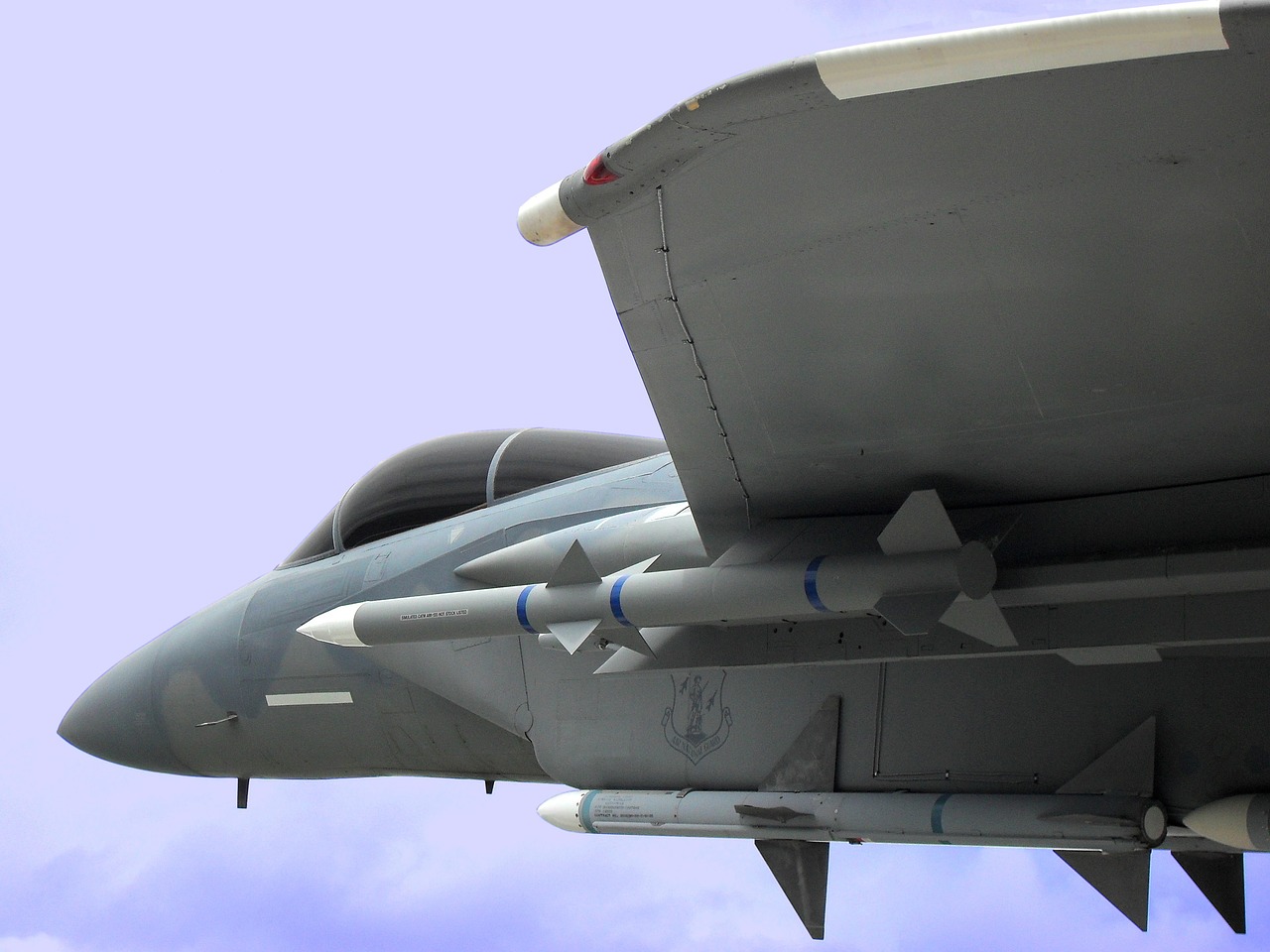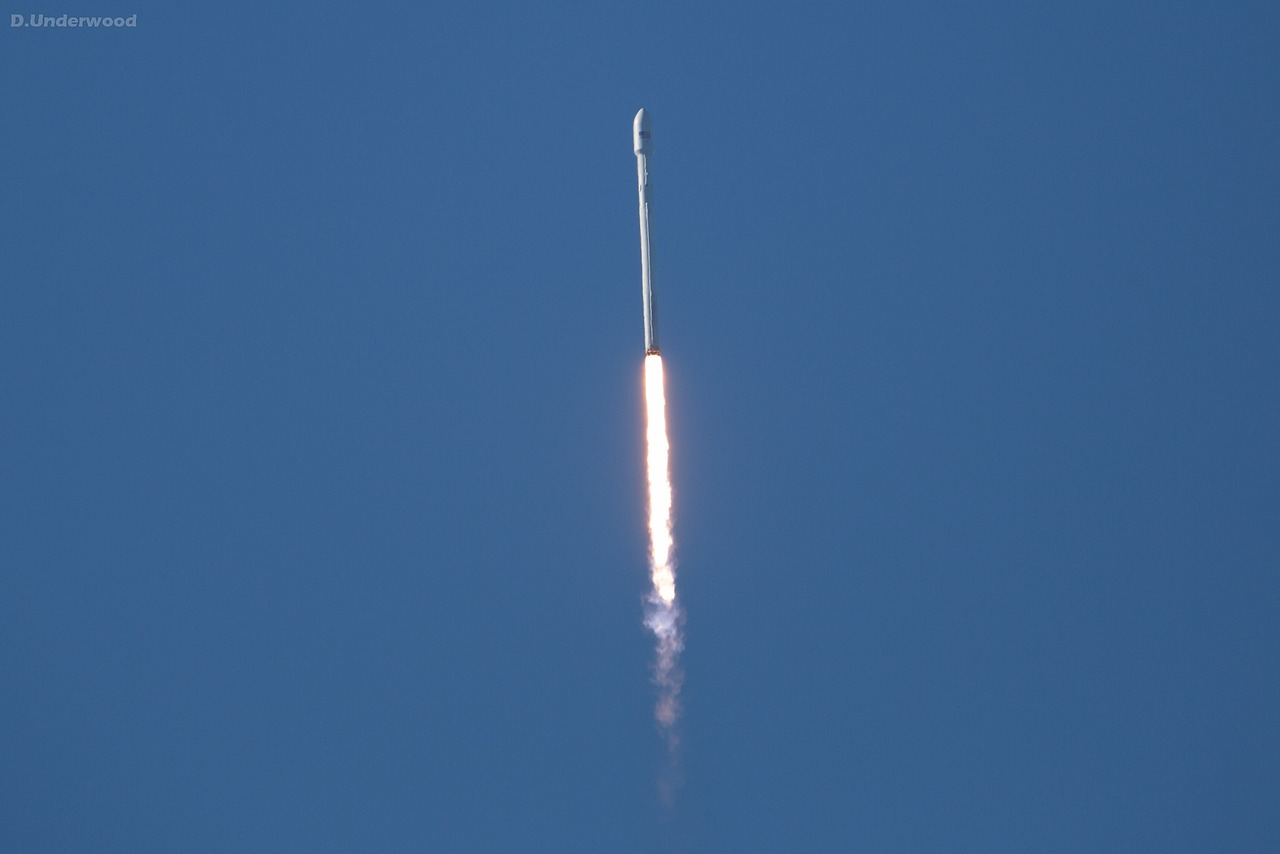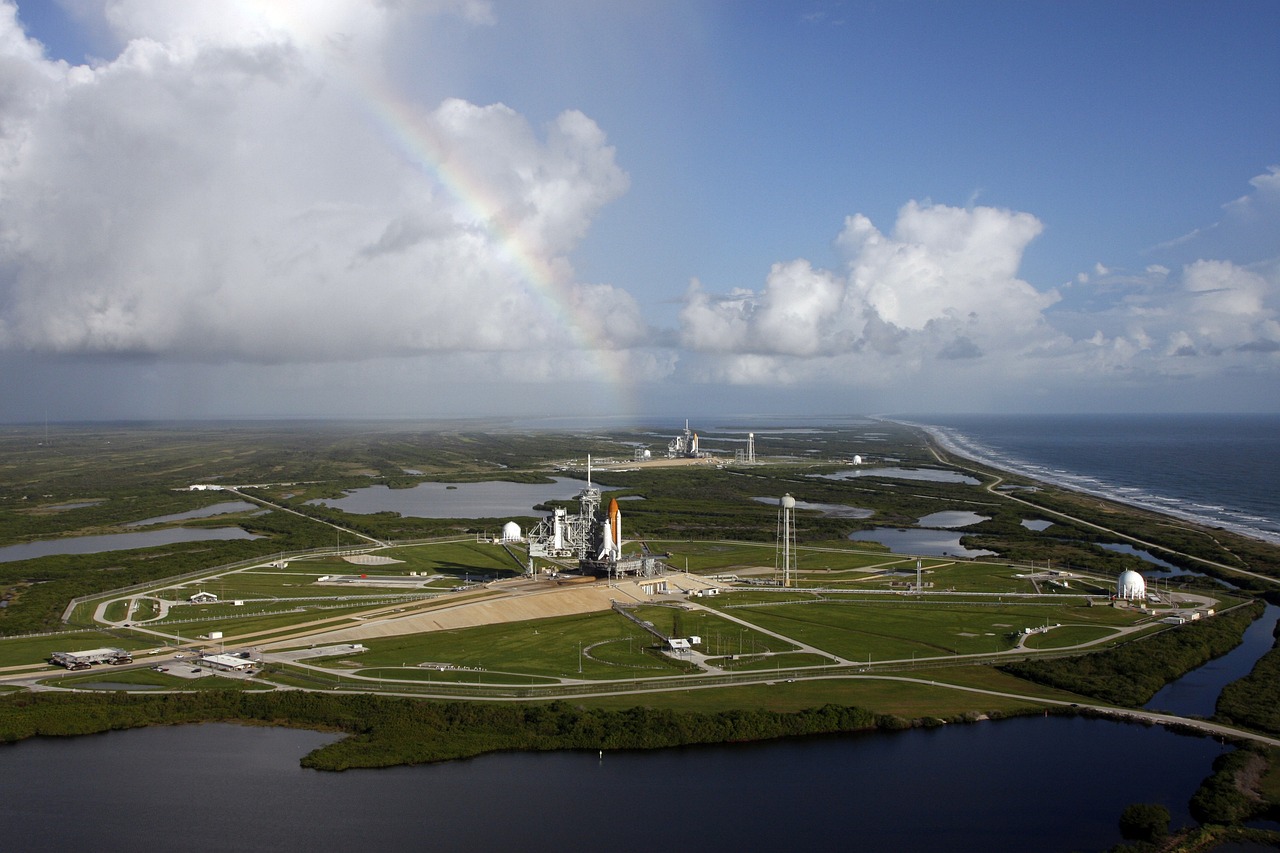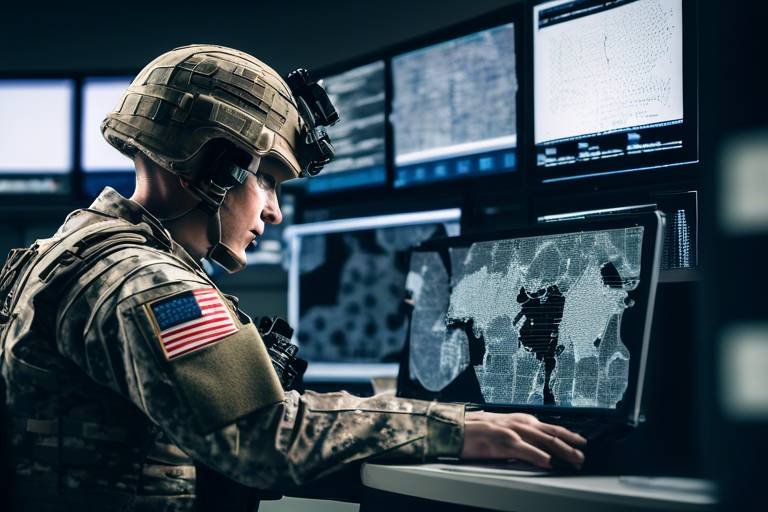The Role of Advanced Algorithms in Missile Guidance Systems
In the fast-paced world of modern warfare, the importance of precision cannot be overstated. Advanced algorithms play a crucial role in missile guidance systems, transforming them into highly sophisticated tools capable of hitting their targets with remarkable accuracy. Imagine a world where a missile can navigate through complex environments, adapt to unforeseen changes, and still strike its target with pinpoint precision. This is no longer a distant dream; it’s the reality brought forth by cutting-edge algorithms that enhance the effectiveness of missile systems.
At the heart of these systems lies a myriad of algorithms designed to process vast amounts of data in real-time. These algorithms are not just mathematical formulas; they are the brains behind the operations, enabling missiles to make split-second decisions that can mean the difference between success and failure. The integration of advanced algorithms ensures that missiles can assess their surroundings, predict target movements, and adjust their paths accordingly. It's akin to having a highly trained pilot inside the missile, making instantaneous calculations and adjustments based on the battlefield dynamics.
The significance of these algorithms extends beyond mere accuracy. They also enhance the efficiency of missile systems, allowing for quicker response times and improved resource management. In a scenario where time is of the essence, the ability to quickly adapt to changing conditions can be a game-changer. For instance, when a target maneuvers unexpectedly, advanced algorithms enable the missile to recalibrate its trajectory almost instantaneously, ensuring that the mission remains on track.
Moreover, the evolution of missile guidance systems is closely tied to technological advancements. The incorporation of artificial intelligence (AI) and machine learning has further revolutionized these systems. By analyzing historical data and learning from past engagements, AI-driven algorithms can predict future target behaviors, making missile guidance not just reactive but also proactive. This capability is vital in modern warfare, where the battlefield is constantly evolving, and threats can emerge from multiple directions.
In summary, the role of advanced algorithms in missile guidance systems is multifaceted. They enhance accuracy, improve efficiency, and enable adaptability in an ever-changing environment. As we look to the future, the continued development of these algorithms, alongside emerging technologies such as quantum computing, promises to take missile guidance systems to unprecedented levels of effectiveness. The battlefield of tomorrow will undoubtedly be shaped by these innovations, making the study and application of advanced algorithms not just relevant but essential.
- What are missile guidance systems?
Missile guidance systems are technologies that ensure missiles reach their intended targets with high precision, utilizing various algorithms to calculate trajectories and make real-time adjustments. - How do advanced algorithms improve missile accuracy?
Advanced algorithms analyze data from multiple sources, enabling missiles to adapt their paths based on real-time information about target movements and environmental conditions. - What is the role of machine learning in missile guidance?
Machine learning algorithms allow missile systems to learn from past engagements, improving their ability to predict target behavior and make informed decisions during flight. - Are there limitations to current missile guidance technologies?
Yes, while advanced algorithms significantly enhance missile guidance, they can face challenges in complex scenarios where targets exhibit unpredictable behavior or when operating in cluttered environments.

Understanding Missile Guidance Systems
Missile guidance systems are the unsung heroes of modern warfare, playing a pivotal role in ensuring that missiles hit their intended targets with pinpoint precision. Imagine a skilled archer, deftly adjusting their aim based on wind speed and direction; missile guidance systems operate on a similar principle, utilizing advanced technology to navigate complex environments and dynamic targets. At their core, these systems are designed to control the trajectory of a missile from launch to impact, ensuring it reaches its destination with the highest possible accuracy.
The fundamental components of missile guidance systems can be broken down into several key elements: guidance algorithms, sensors, and control systems. Each of these components contributes to the overall functionality and effectiveness of the missile. Guidance algorithms determine how the missile should adjust its path based on real-time data, while sensors gather critical information about the missile's surroundings, including the position and movement of the target. Control systems then execute the necessary adjustments to the missile's flight path, ensuring it stays on course.
To illustrate the importance of these components, consider a missile launched towards a moving target, such as a fast-moving vehicle. The guidance algorithm must continuously process data from the sensors to calculate the optimal trajectory, accounting for factors like speed, direction, and distance. This real-time processing is crucial, as even a slight miscalculation could result in a miss, rendering the missile ineffective.
Furthermore, missile guidance systems can be categorized into different types based on their operational principles. Some systems utilize inertial navigation, relying on onboard sensors to track the missile's position. Others employ terminal guidance, which involves directing the missile as it approaches its target, often using radar or infrared homing techniques. The choice of guidance system often depends on the mission requirements and the nature of the target.
As we delve deeper into the intricacies of missile guidance systems, it's essential to recognize that these technologies are not static; they continue to evolve. The integration of advanced algorithms and machine learning techniques is pushing the boundaries of what these systems can achieve, enhancing their accuracy and responsiveness. In the following sections, we will explore the various types of guidance algorithms and their unique functionalities, shedding light on how they contribute to the overall effectiveness of missile systems.
- What are missile guidance systems? Missile guidance systems are technologies that control the trajectory of a missile to ensure it accurately reaches its intended target.
- How do guidance algorithms work? Guidance algorithms process real-time data from sensors to determine the necessary adjustments to the missile's flight path.
- What types of guidance systems exist? There are various types, including inertial navigation and terminal guidance, each suited for different mission requirements.
- How is technology improving missile guidance systems? Advanced algorithms and machine learning are enhancing the accuracy and adaptability of missile guidance systems.

Types of Guidance Algorithms
In the realm of missile guidance systems, advanced algorithms play a pivotal role in determining how effectively a missile can reach its target. These algorithms are not just lines of code; they are the brains behind the operations, providing the necessary calculations and adjustments that ensure precision and efficiency in real-time. Understanding the different types of guidance algorithms is essential for grasping how modern warfare has evolved. Each algorithm serves a unique purpose and is tailored to meet specific operational requirements. Here, we will explore some of the most significant types of guidance algorithms used today.
One of the most prevalent categories is the proportional navigation algorithm. This method is designed to adjust the trajectory of a missile based on the relative motion of its target. Imagine a skilled archer who not only aims at a stationary target but also anticipates its movement, adjusting their shot accordingly. Proportional navigation functions similarly, ensuring that the missile can dynamically respond to changes in the target's path, making it highly effective in engaging fast-moving threats.
Another critical type of algorithm is Kalman filtering. This statistical approach is used for estimating the state of a dynamic system, providing real-time updates on the missile's position and trajectory. Think of it as a GPS for missiles, constantly recalibrating based on new data inputs. Kalman filtering enhances tracking and prediction, allowing the missile to maintain its course even in the face of unexpected obstacles or changes in the target's movement.
In addition to these, there are also adaptive algorithms, which are designed to modify their parameters in real-time. These algorithms are akin to a chameleon, changing their characteristics based on the environment and conditions they encounter. This adaptability is crucial in complex scenarios where traditional algorithms may falter. Furthermore, data fusion techniques are increasingly being integrated into missile guidance systems. By combining data from multiple sources—such as radar, satellite imagery, and onboard sensors—these techniques create a comprehensive picture of the battlefield, significantly enhancing situational awareness and accuracy.
To summarize, the landscape of missile guidance is rich with various algorithms, each contributing to the overall effectiveness of missile systems. The integration of these algorithms not only improves accuracy but also enhances responsiveness to changing conditions, making them indispensable in modern military operations. As we delve deeper into the intricacies of these systems, it's essential to recognize that the future of missile guidance technology will likely see even more sophisticated algorithms emerging, further pushing the boundaries of what is possible in warfare.
- What is the primary function of guidance algorithms in missile systems?
Guidance algorithms are essential for calculating the trajectory and adjustments needed for a missile to reach its target accurately. - How does proportional navigation differ from Kalman filtering?
Proportional navigation focuses on adjusting the missile's path based on the target's movement, while Kalman filtering is used for estimating the missile's current state and trajectory based on various data inputs. - What role do adaptive algorithms play in missile guidance?
Adaptive algorithms allow missile systems to modify their parameters in real-time, enhancing performance in dynamic and unpredictable environments. - Why is data fusion important in missile guidance?
Data fusion combines information from multiple sources to create a more accurate and comprehensive understanding of the battlefield, improving situational awareness and targeting precision.

Proportional Navigation
Proportional navigation is a cornerstone of modern missile guidance systems, renowned for its ability to adaptively steer missiles towards moving targets. At its core, this algorithm calculates the required change in trajectory based on the relative motion between the missile and its target. Imagine a skilled archer adjusting their aim based on the wind and the target's movement; that's essentially what proportional navigation does, but in a high-tech, fast-paced environment.
The mechanics of proportional navigation are relatively straightforward yet highly effective. The missile continuously measures the angle of its line of sight to the target and adjusts its path accordingly. This means that if the target changes direction or speed, the missile can respond almost instantaneously, modifying its trajectory to maintain the most efficient path. The mathematical model behind this involves a simple equation where the missile's acceleration is proportional to the rate at which the line of sight angle changes. This leads to a direct relationship between the missile's maneuverability and the target's evasive actions.
One of the standout features of proportional navigation is its real-time adaptability. Unlike traditional guidance systems that rely on pre-programmed paths, proportional navigation allows for dynamic adjustments. This capability is particularly crucial in modern warfare, where targets can be unpredictable and agile. The algorithm excels in scenarios such as aerial dogfights or anti-ship missile launches, where the targets are often moving at high speeds and can change direction rapidly.
However, while proportional navigation boasts numerous advantages, it is not without its challenges. For instance, in a complex environment with multiple targets or countermeasures, the algorithm may struggle to maintain optimal accuracy. This is where advanced solutions, such as integrating Kalman filtering or machine learning techniques, can enhance its effectiveness. By combining these technologies, missile systems can better predict target movements, further refining the guidance process.
In summary, proportional navigation is a vital component of missile guidance systems, offering enhanced accuracy and responsiveness to target changes. Its ability to adapt in real-time makes it a preferred choice in modern military applications. As missile technology continues to evolve, the integration of proportional navigation with other advanced algorithms promises to unlock even greater potential in the quest for precision and effectiveness in missile deployment.

Benefits of Proportional Navigation
Proportional navigation stands out as one of the most effective algorithms in missile guidance, and its benefits are significant in the realm of modern warfare. One of the primary advantages of this method is its enhanced accuracy. By continuously adjusting the missile's trajectory based on the target's current position and velocity, proportional navigation ensures that the missile remains on a collision course. This dynamic adjustment is akin to a skilled archer who constantly adjusts their aim based on the wind and the movement of their target, thereby increasing the likelihood of a successful hit.
Moreover, the responsiveness of proportional navigation to changes in target movement is another compelling benefit. When a target maneuvers unexpectedly, the algorithm recalibrates the missile's flight path almost instantaneously. This capability is crucial in modern combat scenarios, where targets can change speed or direction rapidly. For instance, consider a dogfight between fighter jets; the ability of missiles to adapt to the erratic movements of these aircraft can be the difference between success and failure.
In addition to accuracy and responsiveness, proportional navigation also offers reduced computational load. The algorithm's design allows for simpler calculations compared to other complex guidance systems, which often require extensive processing power. This efficiency is particularly beneficial in environments where computational resources are limited or when rapid decision-making is essential. Think of it as a quick-thinking chess player who can make strategic moves without overanalyzing every possibility, allowing for a swift and effective response to the opponent's actions.
Furthermore, proportional navigation is versatile and can be applied across various missile types, from air-to-air to surface-to-air systems. This adaptability means that military forces can employ a consistent guidance strategy across different platforms, simplifying training and operational procedures. It’s like having a universal remote control that can operate multiple devices without the need for different remotes for each one.
Lastly, the cost-effectiveness of implementing proportional navigation cannot be overlooked. Given its simplicity and reliability, military organizations can reduce the expenses associated with developing and maintaining more complex guidance systems. This financial benefit allows for the reallocation of resources to other critical areas, such as personnel training or advanced weaponry development. In a world where budgets are often tight, this aspect of proportional navigation makes it an attractive option for defense strategies.
In summary, the benefits of proportional navigation are multifaceted, encompassing enhanced accuracy, responsiveness, reduced computational load, versatility, and cost-effectiveness. As military technology continues to evolve, these advantages will play a pivotal role in shaping the future of missile guidance systems.
- What is proportional navigation? Proportional navigation is a guidance algorithm that adjusts a missile's trajectory based on the movement of its target, ensuring a more accurate strike.
- Why is accuracy important in missile guidance? Accuracy is crucial because it determines the likelihood of hitting the intended target, which can significantly affect mission success and operational effectiveness.
- How does proportional navigation adapt to target movements? The algorithm continuously calculates the required adjustments to the missile's flight path based on real-time data about the target's position and velocity.
- Are there any limitations to proportional navigation? Yes, while it is effective in many scenarios, it may struggle in highly complex environments where targets exhibit unpredictable behavior.

Limitations of Proportional Navigation
While proportional navigation has become a cornerstone in missile guidance systems due to its effectiveness and responsiveness, it is not without its limitations. One of the primary challenges is its performance in highly dynamic environments. In scenarios where both the missile and the target are maneuvering rapidly, the algorithm can struggle to maintain accuracy. This is particularly evident in situations where the target executes sudden, unpredictable movements, leading to potential miss distances that could compromise mission success.
Another significant limitation arises from the inherent assumptions made by the proportional navigation algorithm. It often assumes a constant target velocity and a predictable trajectory. However, in real-world applications, targets can exhibit erratic behaviors, such as sudden acceleration or deceleration, which can lead to tracking errors. These errors can be exacerbated in environments with high clutter or when dealing with multiple targets, as the algorithm may find it challenging to discern which target to prioritize.
Additionally, the effectiveness of proportional navigation can be hindered by the missile's own performance characteristics. For example, if a missile has limited maneuverability or a slow response time, it may not be able to adjust its flight path quickly enough to intercept a highly maneuvering target. This limitation necessitates the integration of more sophisticated algorithms or hybrid systems that can adapt to varying conditions.
Moreover, the reliance on proportional navigation can lead to predictable patterns in missile behavior, making it easier for adversaries to develop countermeasures. If a missile consistently follows a similar trajectory based on its navigation algorithm, it may become vulnerable to interception. As such, the challenge lies in balancing the effectiveness of proportional navigation with the need for unpredictability in missile trajectories.
In summary, while proportional navigation offers numerous advantages in missile guidance, its limitations highlight the need for continuous advancements in missile technology. By addressing these challenges, defense systems can enhance their effectiveness in an increasingly complex battlefield environment. Future developments may incorporate elements such as machine learning and data fusion to create more adaptable and resilient missile guidance systems.
- What is proportional navigation? Proportional navigation is a guidance algorithm that adjusts a missile's trajectory based on the relative motion of the target, aiming to intercept it effectively.
- What are the main limitations of proportional navigation? The main limitations include performance issues in dynamic environments, reliance on constant target velocity assumptions, and predictability in missile behavior.
- How can these limitations be addressed? Integrating advanced algorithms, such as machine learning and adaptive systems, can help improve missile guidance in complex scenarios.
- Why is unpredictability important in missile trajectories? Unpredictability helps prevent adversaries from developing effective countermeasures, enhancing the chances of successful interception.

Kalman Filtering
Kalman filtering is a sophisticated statistical method that plays a pivotal role in the realm of missile guidance systems. At its core, this algorithm is designed to estimate the state of a dynamic system over time, utilizing a series of measurements that may contain noise and other inaccuracies. Imagine trying to track a moving object through a foggy environment; each observation you make might be obscured by the haze, yet you still want to pinpoint the object’s location as accurately as possible. This is precisely where Kalman filtering shines, as it systematically refines its predictions based on previous estimates and new observations.
The fundamental principle behind Kalman filtering is its ability to calculate a weighted average of the estimates, where more reliable measurements are given greater weight. This dynamic adjustment allows the algorithm to continuously update its predictions, which is crucial in the fast-paced context of missile guidance. The algorithm operates in two main phases: the prediction phase and the update phase. During the prediction phase, it forecasts the future state of the missile based on its current trajectory and speed. Then, in the update phase, it incorporates new data from sensors to refine this prediction, leading to a more accurate assessment of the missile's position and velocity.
One of the most compelling aspects of Kalman filtering is its ability to work with various types of data inputs, such as radar signals, GPS coordinates, and inertial measurements. This feature is particularly important in modern missile systems where data fusion from multiple sources is essential for maintaining situational awareness. By integrating these diverse inputs, Kalman filters can produce a cohesive and reliable estimate of the missile's trajectory, even in the face of uncertainties.
To illustrate how Kalman filtering operates, consider the following simplified table that outlines its two main phases:
| Phase | Description |
|---|---|
| Prediction Phase | Estimates the future state of the missile based on current data and motion models. |
| Update Phase | Refines the prediction using new measurements, adjusting for noise and inaccuracies. |
However, while Kalman filtering offers remarkable advantages, it is not without its challenges. The effectiveness of the algorithm is heavily dependent on the accuracy of the models used to predict the missile's motion and the statistical properties of the noise in the measurements. If the assumptions made about these factors are incorrect, the performance of the Kalman filter can degrade significantly.
In conclusion, Kalman filtering is a cornerstone of modern missile guidance systems, enabling improved tracking and prediction capabilities. Its ability to adapt and refine estimates in real-time makes it invaluable in the fast-evolving landscape of warfare technology. As missile systems become more advanced, the role of Kalman filtering will likely expand, driving further innovations in accuracy and effectiveness.
- What is Kalman filtering? Kalman filtering is a statistical method used to estimate the state of a dynamic system by minimizing the mean of the squared errors.
- How does Kalman filtering improve missile guidance? It enhances missile guidance by providing real-time updates and predictions based on multiple noisy measurements.
- What are the phases of Kalman filtering? The two main phases are the prediction phase, where future states are estimated, and the update phase, where new measurements refine these estimates.
- What types of data can Kalman filters process? Kalman filters can process various data types, including radar signals, GPS data, and inertial measurement unit outputs.

Machine Learning in Missile Guidance
In today's rapidly evolving technological landscape, machine learning (ML) is emerging as a game-changer in various fields, and missile guidance systems are no exception. Imagine a world where missiles can learn from their environment and adapt in real-time, much like a seasoned athlete adjusting their strategy mid-game. This is the kind of potential that machine learning brings to the table, enhancing the accuracy and efficiency of missile guidance systems.
At its core, machine learning involves algorithms that can analyze data, learn from it, and make predictions or decisions without being explicitly programmed for each scenario. In missile guidance, this means that the system can process vast amounts of data from various sensors and sources, enabling it to make informed decisions on the fly. The integration of ML algorithms leads to improved decision-making processes, allowing missiles to adjust their flight paths based on real-time data regarding target movements, environmental conditions, and potential obstacles.
One of the most significant advancements brought about by machine learning is the development of adaptive algorithms. These algorithms can change their parameters in response to the dynamic nature of the battlefield. For example, if a missile is approaching a target that suddenly changes course, an adaptive algorithm can quickly recalibrate the missile's trajectory. This adaptability is crucial in modern warfare, where the unpredictability of targets can significantly affect mission success.
Moreover, the role of data fusion techniques cannot be overstated. By combining information from multiple sources—such as radar, satellite imagery, and onboard sensors—data fusion creates a comprehensive picture of the battlefield. This holistic view allows missile guidance systems to make more informed decisions, ultimately increasing accuracy and situational awareness. In essence, data fusion acts like a conductor in an orchestra, harmonizing various inputs to produce a coherent output that enhances the overall performance of missile systems.
As we look to the future, the potential of machine learning in missile guidance is only beginning to be realized. With advancements in AI and increased computational power, we can expect to see even more sophisticated algorithms that push the boundaries of what is possible. These innovations will not only improve the effectiveness of missile systems but also ensure that they can operate in increasingly complex environments, adapting to new challenges as they arise.
- What is machine learning in missile guidance? Machine learning in missile guidance refers to the use of algorithms that enable missiles to learn from data and adapt their behavior in real-time, improving accuracy and decision-making.
- How do adaptive algorithms work? Adaptive algorithms adjust their parameters based on real-time data, allowing missiles to recalibrate their trajectories in response to changes in target movement or environmental conditions.
- What is data fusion, and why is it important? Data fusion combines information from various sources to create a comprehensive view of the battlefield, enhancing situational awareness and improving the accuracy of missile guidance systems.
- What are the future prospects for machine learning in missile guidance? The future of machine learning in missile guidance is promising, with advancements in AI and computational power expected to lead to even more sophisticated algorithms and improved system capabilities.

Adaptive Algorithms
Adaptive algorithms are at the forefront of modern missile guidance systems, making them smarter and more responsive to changing environments. Imagine a missile as a skilled athlete, constantly adjusting its position and strategy based on the opponent's moves. That’s precisely what adaptive algorithms do—they allow missiles to recalibrate their paths in real-time, ensuring they stay on target even when conditions shift unexpectedly.
These algorithms utilize feedback loops to continuously improve their performance. By analyzing data from various sensors and sources, they can modify their parameters, enhancing their ability to track and engage dynamic targets. For instance, if a target suddenly accelerates or changes direction, an adaptive algorithm can quickly adjust the missile's trajectory to maintain accuracy. This capability is crucial in modern warfare, where split-second decisions can mean the difference between success and failure.
One of the standout features of adaptive algorithms is their ability to learn from previous engagements. They can analyze past performance data to identify patterns and make predictions about future target behavior. This learning capability transforms missiles into intelligent systems that not only follow predefined paths but also adapt to new tactics and strategies employed by adversaries. The result? Increased effectiveness in combat scenarios where unpredictability reigns supreme.
To illustrate the power of adaptive algorithms, consider the following table that highlights key characteristics:
| Characteristic | Description |
|---|---|
| Real-time Adjustment | Modifies trajectory based on immediate feedback from sensors. |
| Learning Capability | Analyzes past data to improve future performance. |
| Dynamic Target Engagement | Effectively tracks and engages moving targets. |
| Robustness | Maintains performance under various environmental conditions. |
Moreover, adaptive algorithms are not just limited to missile guidance; they have potential applications in various fields, including autonomous vehicles, robotics, and even financial trading systems. Their versatility makes them a hot topic in technology and defense circles alike. As we move forward, the integration of these algorithms will undoubtedly lead to more sophisticated and capable missile systems, enhancing both precision and reliability.
In conclusion, the role of adaptive algorithms in missile guidance is transformative. By enabling real-time adjustments and learning from past experiences, these algorithms enhance the missile's ability to adapt to complex and unpredictable combat environments. As technology continues to evolve, we can expect adaptive algorithms to play an even more significant role in shaping the future of warfare.
- What are adaptive algorithms? Adaptive algorithms are systems that modify their behavior in response to changing conditions and feedback, enhancing performance in dynamic environments.
- How do adaptive algorithms improve missile guidance? They allow missiles to adjust their trajectories in real-time based on target movement and environmental factors, increasing accuracy and effectiveness.
- Can adaptive algorithms be used in other fields? Yes, they have applications in areas such as autonomous vehicles, robotics, and financial systems, showcasing their versatility.
- What is the future of adaptive algorithms in missile systems? As technology advances, we can expect further integration of adaptive algorithms, leading to more sophisticated and capable missile systems.

Data Fusion Techniques
Data fusion techniques are at the forefront of enhancing missile guidance systems, acting as the glue that binds various sources of information into a coherent and actionable understanding of the battlefield. Imagine trying to piece together a jigsaw puzzle where the pieces are scattered across different tables; data fusion does just that by integrating disparate data streams from sensors, satellite imagery, and intelligence reports. This integration is crucial, as it allows missile systems to have a comprehensive view of their environment, leading to better decision-making and improved targeting accuracy.
At its core, data fusion involves the combination of data from multiple sources to produce a more complete and accurate representation of the situation. In missile guidance, this can include data from radar, infrared sensors, and even weather forecasts. By synthesizing this information, missile systems can adapt to changing conditions and enhance their effectiveness. For instance, if a missile is equipped with multiple sensors, data fusion algorithms can determine the most reliable source of information at any given moment, ensuring that the missile remains on track even if one sensor is compromised or providing erroneous data.
One of the key methodologies used in data fusion is the multi-sensor fusion approach, which leverages the strengths of various sensors while compensating for their weaknesses. This technique can significantly enhance situational awareness, allowing missile systems to differentiate between real targets and decoys. For example, if radar detects an object but infrared sensors do not, the system can use algorithms to assess the likelihood of that object being a legitimate target, thus minimizing the chances of a miss.
Moreover, data fusion techniques can also facilitate the real-time processing of information, which is essential in fast-paced combat scenarios. With the rapid advancements in computing power and algorithms, missile systems can now process and analyze data in milliseconds, allowing them to react to threats almost instantaneously. This speed is crucial; in modern warfare, every second counts, and the ability to make split-second decisions can mean the difference between mission success and failure.
To illustrate the impact of data fusion techniques, consider the following table that summarizes the benefits of implementing these technologies in missile guidance systems:
| Benefit | Description |
|---|---|
| Improved Accuracy | Combining data from multiple sensors reduces the likelihood of errors in target identification and tracking. |
| Enhanced Situational Awareness | Integrating diverse information sources provides a comprehensive view of the battlefield, improving decision-making. |
| Increased Resilience | Redundancy in data sources ensures that the missile system can continue to function effectively even if one sensor fails. |
| Real-time Adaptability | Fast processing of incoming data allows missile systems to adjust their strategies on the fly. |
In summary, data fusion techniques play a pivotal role in modern missile guidance systems, transforming raw data into actionable intelligence. By integrating various streams of information, these techniques enhance the accuracy, efficiency, and overall effectiveness of missile operations. As technology continues to evolve, the potential for even more sophisticated data fusion methods promises to further revolutionize the landscape of missile guidance, making them smarter and more responsive to the dynamic nature of warfare.
- What is data fusion in missile guidance systems? Data fusion refers to the process of integrating information from multiple sources to create a comprehensive understanding of the battlefield, enhancing targeting accuracy and situational awareness.
- How does data fusion improve missile accuracy? By combining data from various sensors, data fusion reduces errors in target identification and tracking, leading to more precise missile strikes.
- What are the key benefits of using data fusion techniques? Key benefits include improved accuracy, enhanced situational awareness, increased resilience, and real-time adaptability to changing conditions.
- How fast can missile systems process data through fusion techniques? With advancements in computing power, missile systems can process and analyze data in milliseconds, allowing for rapid decision-making.

The Future of Missile Guidance Technologies
As we stand on the brink of a technological revolution, the future of missile guidance systems is poised for extraordinary advancements. Imagine a world where missiles can not only adapt to changing environments but also make real-time decisions based on complex data inputs. This is not just a dream; it's becoming a reality with the integration of artificial intelligence (AI) and quantum computing. These innovations promise to enhance the precision and effectiveness of missile systems, making them more reliable than ever before.
One of the most exciting developments on the horizon is the use of AI algorithms that can learn from past engagements. Picture a missile that, instead of relying solely on pre-programmed paths, can analyze its surroundings and adjust its trajectory based on live data. This capability could significantly reduce collateral damage and improve mission success rates. Additionally, as AI continues to evolve, we can expect to see more sophisticated decision-making processes that allow missiles to predict and counteract evasive maneuvers by targets.
Another groundbreaking technology is quantum computing, which holds the potential to process vast amounts of data at unprecedented speeds. This could revolutionize missile guidance systems by enabling real-time data fusion from multiple sources, enhancing situational awareness. With quantum computing, the ability to track multiple targets simultaneously and predict their movements with high accuracy could become standard practice. This would represent a paradigm shift in how we approach missile guidance, making systems not just reactive but also proactive.
Moreover, the future will likely see the rise of networked missile systems, where multiple units communicate and collaborate to achieve a common objective. This interconnectedness can lead to improved coordination and efficiency, akin to a swarm of bees working together to achieve a goal. By sharing information in real-time, these systems can adapt to threats more effectively, creating a formidable defense mechanism.
However, with these advancements come challenges. The integration of AI and quantum computing raises questions about security and ethical considerations. How do we ensure that these powerful technologies are not misused? As we delve deeper into the future of missile guidance technologies, it is imperative to establish robust frameworks that govern their use, ensuring that they serve to protect rather than endanger.
In conclusion, the future of missile guidance technologies is bright and full of potential. As we harness the power of AI and quantum computing, we can expect a transformation that not only enhances the effectiveness of missile systems but also redefines the very nature of modern warfare. The key will be to balance innovation with responsibility, ensuring that these advancements contribute to global security rather than escalating conflicts.
- What role does AI play in missile guidance systems? AI enhances decision-making and adaptability, allowing missiles to adjust their paths based on real-time data.
- How can quantum computing improve missile guidance? Quantum computing can process vast amounts of data quickly, enabling better tracking and prediction of target movements.
- What are the ethical considerations surrounding advanced missile technologies? The use of AI and quantum computing raises concerns about security and the potential for misuse, necessitating strict governance frameworks.
- Will networked missile systems be more effective? Yes, by allowing multiple units to communicate and collaborate, networked systems can improve coordination and overall efficiency.
Frequently Asked Questions
- What are missile guidance systems?
Missile guidance systems are sophisticated technologies designed to ensure that missiles accurately reach their intended targets. They utilize a combination of sensors, algorithms, and control systems to track targets and adjust the missile's trajectory in real-time.
- How do advanced algorithms improve missile guidance?
Advanced algorithms enhance missile guidance by increasing accuracy and efficiency. They analyze data from various sources, predict target movements, and adjust the missile's path accordingly, ensuring a higher probability of hitting the target even in dynamic environments.
- What is proportional navigation?
Proportional navigation is a widely adopted algorithm in missile guidance that adjusts a missile's trajectory based on the relative motion between the missile and its target. This method allows for quick responses to changes in target speed and direction, improving hit accuracy.
- What are the limitations of proportional navigation?
While proportional navigation is effective, it has limitations, particularly in complex scenarios where targets exhibit unpredictable movements. These challenges can lead to reduced accuracy, prompting the need for advanced solutions like adaptive algorithms and data fusion techniques.
- How does Kalman filtering work in missile guidance?
Kalman filtering is a statistical method that estimates the state of a dynamic system by processing noisy measurements over time. In missile guidance, it helps in tracking and predicting the target's position, significantly enhancing the system's decision-making capabilities.
- What role does machine learning play in missile guidance systems?
Machine learning algorithms are transforming missile guidance by enabling systems to learn from data and adapt to changing conditions. This leads to improved decision-making and operational effectiveness, allowing missiles to respond dynamically to real-time threats.
- What are adaptive algorithms?
Adaptive algorithms are designed to modify their parameters in real-time based on the environment and target behavior. In missile guidance, they enhance performance by continuously adjusting to varying conditions, ensuring that the missile remains on course.
- What is data fusion and why is it important?
Data fusion involves integrating information from multiple sources to create a unified picture of the operational environment. In missile guidance, it enhances situational awareness and accuracy, allowing for more informed decision-making during flight.
- What does the future hold for missile guidance technologies?
The future of missile guidance technologies looks promising, with advancements in artificial intelligence and quantum computing potentially revolutionizing how missiles are guided. These innovations could lead to even greater accuracy, adaptability, and effectiveness in modern warfare.



















